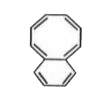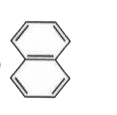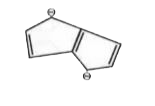Which of the following is polar ? .
NF3
BF3
SF6
SiF4
The correct Answer is:A
To determine which of the given molecules is polar, we need to analyze the molecular geometry and the electronegativity of the atoms involved in each molecule. Here's a step-by-step solution:
Step 1: Analyze NF3 (Nitrogen Trifluoride)
- Structure: NF3 has a nitrogen atom at the center with three fluorine atoms attached and one lone pair of electrons on nitrogen.
- Electronegativity: Fluorine is more electronegative than nitrogen, which means the bond moments (dipoles) point towards the fluorine atoms.
- Lone Pair: The lone pair on nitrogen also contributes to the molecular dipole moment, pointing away from nitrogen.
- Net Dipole Moment: The bond dipoles do not cancel out due to the presence of the lone pair, resulting in a net dipole moment.
- Conclusion: NF3 is a polar molecule.
Step 2: Analyze BF3 (Boron Trifluoride)
- Structure: BF3 has a boron atom at the center with three fluorine atoms arranged in a trigonal planar geometry.
- Electronegativity: The bond moments point towards the fluorine atoms.
- Symmetry: The geometry is symmetrical, and the bond dipoles cancel each other out.
- Net Dipole Moment: The net dipole moment is zero.
- Conclusion: BF3 is a nonpolar molecule.
Step 3: Analyze SF6 (Sulfur Hexafluoride)
- Structure: SF6 has a sulfur atom at the center with six fluorine atoms in a square bipyramidal arrangement.
- Electronegativity: The bond moments point towards the fluorine atoms.
- Symmetry: The symmetrical arrangement means that the bond dipoles cancel each other out.
- Net Dipole Moment: The net dipole moment is zero.
- Conclusion: SF6 is a nonpolar molecule.
Step 4: Analyze SiF4 (Silicon Tetrafluoride)
- Structure: SiF4 has a silicon atom at the center with four fluorine atoms arranged in a tetrahedral geometry.
- Electronegativity: The bond moments point towards the fluorine atoms.
- Symmetry: The tetrahedral shape allows for the bond dipoles to cancel each other out.
- Net Dipole Moment: The net dipole moment is zero.
- Conclusion: SiF4 is a nonpolar molecule.
Final Conclusion
After analyzing all four molecules:
- Polar Molecule: NF3
- Nonpolar Molecules: BF3, SF6, SiF4
Thus, the answer to the question "Which of the following is polar?" is NF3.
---
- Structure: NF3 has a nitrogen atom at the center with three fluorine atoms attached and one lone pair of electrons on nitrogen.
- Electronegativity: Fluorine is more electronegative than nitrogen, which means the bond moments (dipoles) point towards the fluorine atoms.
- Lone Pair: The lone pair on nitrogen also contributes to the molecular dipole moment, pointing away from nitrogen.
- Net Dipole Moment: The bond dipoles do not cancel out due to the presence of the lone pair, resulting in a net dipole moment.
- Conclusion: NF3 is a polar molecule.
- Structure: BF3 has a boron atom at the center with three fluorine atoms arranged in a trigonal planar geometry.
- Electronegativity: The bond moments point towards the fluorine atoms.
- Symmetry: The geometry is symmetrical, and the bond dipoles cancel each other out.
- Net Dipole Moment: The net dipole moment is zero.
- Conclusion: BF3 is a nonpolar molecule.
- Structure: SF6 has a sulfur atom at the center with six fluorine atoms in a square bipyramidal arrangement.
- Electronegativity: The bond moments point towards the fluorine atoms.
- Symmetry: The symmetrical arrangement means that the bond dipoles cancel each other out.
- Net Dipole Moment: The net dipole moment is zero.
- Conclusion: SF6 is a nonpolar molecule.
- Structure: SiF4 has a silicon atom at the center with four fluorine atoms arranged in a tetrahedral geometry.
- Electronegativity: The bond moments point towards the fluorine atoms.
- Symmetry: The tetrahedral shape allows for the bond dipoles to cancel each other out.
- Net Dipole Moment: The net dipole moment is zero.
- Conclusion: SiF4 is a nonpolar molecule.
After analyzing all four molecules:
- Polar Molecule: NF3
- Nonpolar Molecules: BF3, SF6, SiF4
Topper's Solved these Questions
- CHEMICAL BONDING AND MOLECULAR STRUCTUREBOOK - CENGAGE CHEMISTRY ENGLISHCHAPTER - CHEMICAL BONDING AND MOLECULAR STRUCTUREEXERCISE - Exercises Single Correct (Hybridisation)
33 Videos
- CHEMICAL BONDING AND MOLECULAR STRUCTUREBOOK - CENGAGE CHEMISTRY ENGLISHCHAPTER - CHEMICAL BONDING AND MOLECULAR STRUCTUREEXERCISE - Exercises Single Correct (Bond Angle)
10 Videos
- CHEMICAL BONDING AND MOLECULAR STRUCTUREBOOK - CENGAGE CHEMISTRY ENGLISHCHAPTER - CHEMICAL BONDING AND MOLECULAR STRUCTUREEXERCISE - Exercises Single Correct (Chemical Bonding)
46 Videos
- ATOMIC STRUCTUREBOOK - CENGAGE CHEMISTRY ENGLISHCHAPTER - ATOMIC STRUCTUREEXERCISE - Concept Applicationexercise(4.3)
19 Videos
- CHEMICAL EQUILIBRIUMBOOK - CENGAGE CHEMISTRY ENGLISHCHAPTER - CHEMICAL EQUILIBRIUMEXERCISE - Subjective type
1 Videos
Similar Questions
Knowledge Check
Which of the following is non polar species.
ASO2BCO2CH2ODNH3Which of the following is most polar?
A B
B C
C D
D
Which of the following is a polar moleucule?
View SolutionWhich of the following is a polar molecule
View SolutionWhich of the following is non-polar but contains polar bonds?
View SolutionWhich of the following is non-polar molecular solid?
View SolutionWhich of the following is most polar bond ?
View SolutionWhich of the following is a non-polar amino acid?
(a) Alanine
(b) Glutamic acid
(c) Serine
(d) none of these
View Solution
